|
Portable
Rock Art / Figure Stones in |
|
Germany |
|
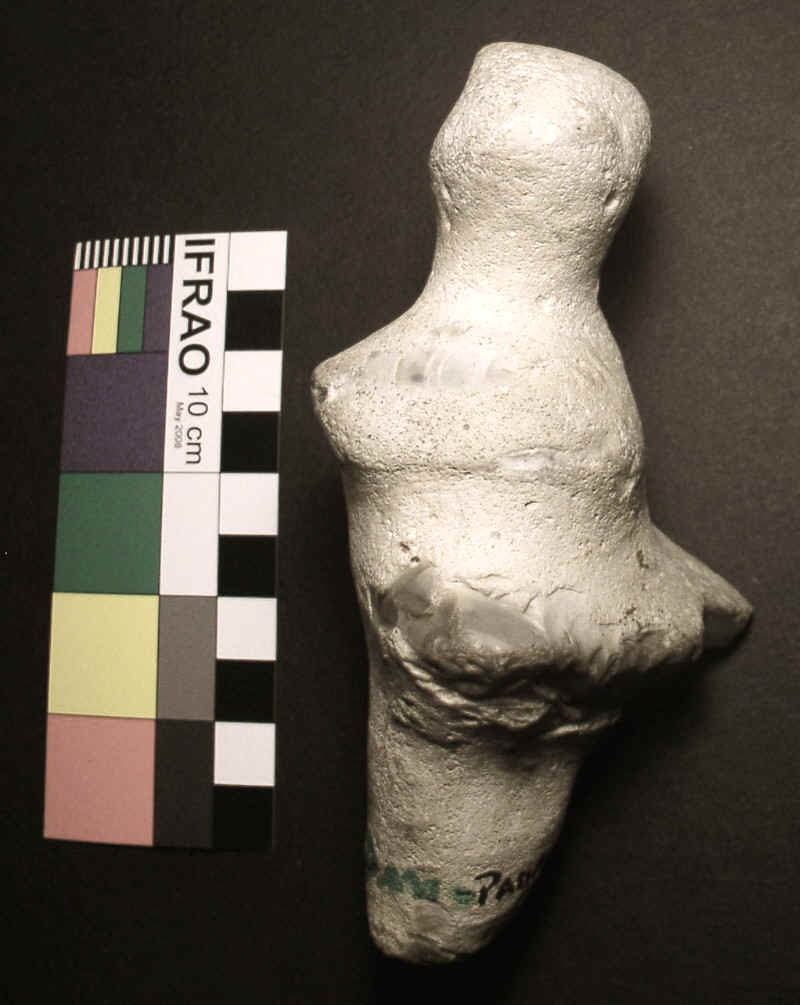
|
|
The
Venus of Pampau |
|
An
Artificially
Flaked Flint Nodule |
|
Recovered
by Ursel Benekendorff from deep in glacial till |
|
at
Groß Pampau, Schleswig-Holstein in 1986 |
|
Click
HERE
to read a laboratory assessment of this artifact. |
|
|

|
|
Ursel
Benekendorff in her garden in Geesthacht near Hamburg,
with
two Groß Pampau artifacts - similar form, different
sizes. |
|
Since 1984
Mrs. Benekendorff has devoted much of her life to the recovery, preservation, and
analysis of artifacts from glacial till far beneath the current terrain surface at
the Ohle (now Ohle & Lau) gravel quarry by Groß Pampau near Hamburg.
Initially looking only for fossils, she began to
notice obvious flint tools of ancient typology, as
well as artifacts of a clearly iconistic nature.
For several years she visited the site as often as possible,
and with the kind permission of Mr. Ohle stood or
crouched hours-long by the conveyor belt transporting
stones to the rock crusher, rescuing hundreds of them.
|
In
2024 Mrs. Benekendorff set up a display of
some of the many Groß Pampau artifacts.
This small museum in Geesthacht is available for free viewing by members of
the general public, by appointment. |
|
Tel.
04152 78502 |
|
Email Ursel.Benekendorff@T-online.de |
Early
on, Mrs. Benekendorff was inspired and encouraged by
Prof. Emeritus Walther Matthes of the University of
Hamburg. In the late 1980s she was assisted by
several notable avocational researchers from Holland,
incl. Jan Evert Musch and Ben Dupen. In 1989 American anthropologist Dr. James
B. Harrod (on the right in the photo below) visited the site to view the artifacts and to
investigate the stratigraphy to the extent that this
was possible. He presents photos and
descriptions of some of the artifacts at originsnet.org. (Dr. Harrod,
along with his colleague Dr. Richard M. Gramly, has recently taken a
very active and welcome interest in North American
figure stones / portable rock art, particularly in the
context of cultural/thematic continuity from northeastern
Asia.)
|
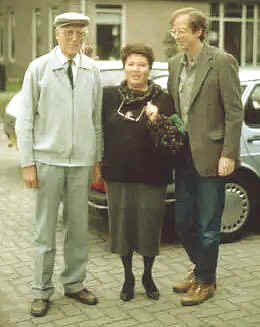
|
|
1989
- Ben Dupen, Ursel Benekendorff, James Harrod
in Elst, Holland |
In 2015
I photographed a few of her Figure Stones, Acheulean
handaxes, etc., several of which have
been brought to Ohio and conclusively confirmed as artifacts by
professional archaeologists and by Dr. Eric Law, petrologist and professor of geology, who examined the flint
"Venus" figure at Muskingum University in Ohio.
In 2017 I returned to Germany and photographed several more of the artifacts, concentrating on tools and physical evidence of human
manufacture, both in the tools and in the Figure
Stones. These photos are in the (slow) process
of being added to those from 2015. |
|
To see some of the artifacts
photographed in 2015 and 2017 |
|
click on the image
below: |
|
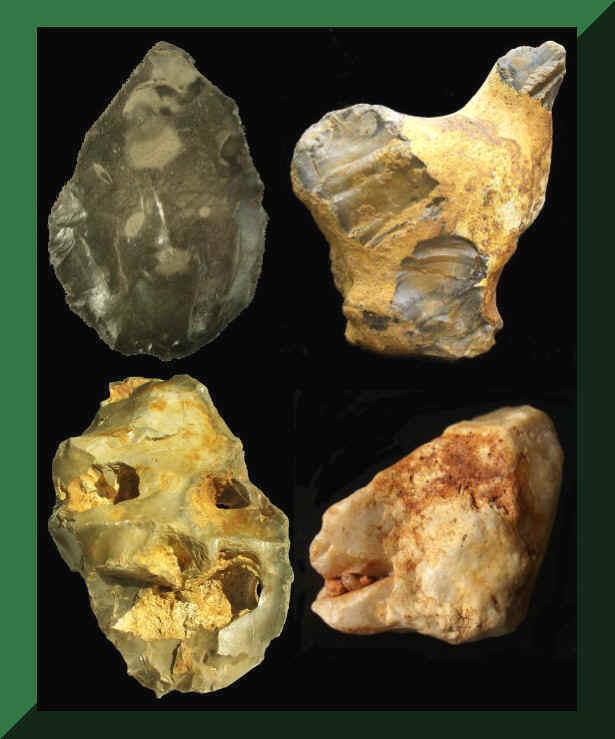
|
|
Mrs.
Benekendorff's own website is schafftwissen.de |
|
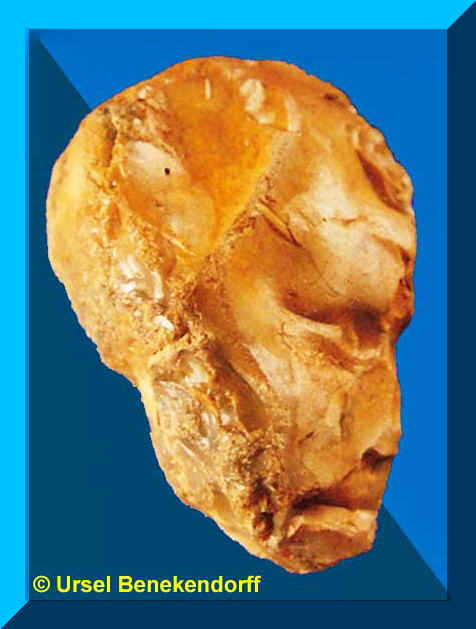
|
In the Geosciences
Dept. of Akron University in Ohio, the zoomorphic flint shown below, with tooth-like pebbles wedged into a crevice, has been determined by XRF/EDS spectroscopy
(Prof. Thomas Quick) to have been artificially colored with
red ochre, both powdered and in a paste-like matrix of
not-yet-determined composition:
|
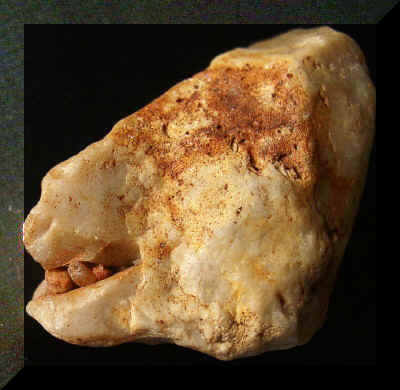
|
|
Click
image for closer photos and spectrum charts. |
|

|
|
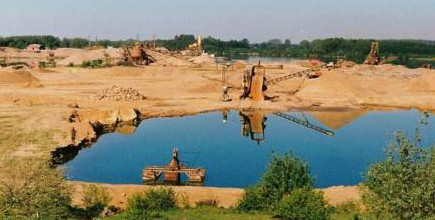
|
|
Above,
the
find site in the 1980s. |
|
Below,
the
find site in 2015. |
|

|
Judging from currently available geostratigraphic data and varying professional opinions, Mrs. Benekendorff's artifact material, retrieved from seven to eighteen meters (23'-60') down in a quarried gravel pit, is currently hypothesized to likely be from both Saalian and Elsterian glacial till along with some end-stage Weichselian solifluction soil in the upper stratum.
And all this overlies or has intruded into fossil-bearing Miocene micaceous
clay, from about 11 million years ago. Quite remarkably, the whole conglomeration
has, over the millenia, been forced upward to a relatively
accessible depth by the expansion of an underlying salt
dome. A more precise determination of the area's geostratigraphy (a bit of a mess) will require much further investigation and inquiry, depending on available time,
resources, and interest. Meanwhile there is
the sketch below from fall 1983 of the quarry's east wall by Lewandowski for Dr. Hans-Jürgen Lierl (Univ. of Hamburg) apparently showing schematically, and not to scale, the stratigraphic components from Weichselian down to Miocene.
(Thanks to Dr.
James Harrod for bringing this drawing to my attention.)
Doctorate-level
Dutch flint experts, looking at
some of my high-resolution photos of the finds, have identified the
flint material of which the artifacts were
manufactured as having originated in Denmark, Sweden, and the Baltic Sea area.
Conservatively assuming the most recent artifact material to have been transported by the Weichselian ice sheet and mixed with that from the Saalian, it seems reasonable to think, at least tentatively,
that the artifacts' age overall may range from early Middle Palaeolithic to Upper Palaeolithic, or very roughly 300,000 to 25,000 years BP.
The morphology/typology of confirmed artifacts in the assemblage seems reasonably consistent with this.
If some of the artifacts have been transported by
the Elsterian ice sheet, these could be Lower
Palaeolithic, or as old as 500,000 years.
Altogether,
this has interesting implications for the long-held
assumption that early humans and/or their predecessors did not
venture as far north as Scandinavia prior to the
last ice age.
No claim is made that this was a formal controlled archaeological dig, being more of a
salvage operation (and certainly a heroic one at that).
The evidence is simply presented for further consideration and investigation, which it clearly
deserves but probably will not receive.
(Although generally more technically competent than
their American counterparts, German archaeologists
seem no less fearful of pursuing anything this
controversial - especially so when the initial
discovery was made by someone who is neither male
nor a
professional archaeologist.)
|
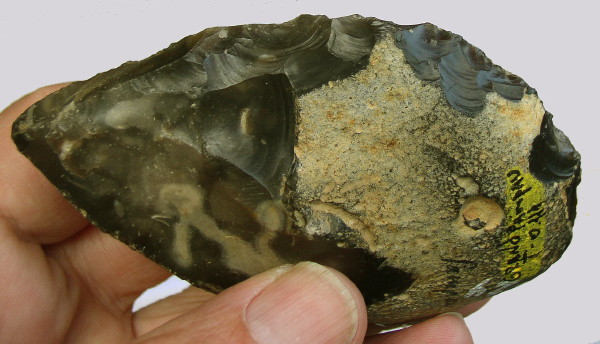
|
|
Above,
a verified Acheulean-style (Middle
Palaeolithic?) handaxe from the site,
made of flint likely having originated in
southern Sweden.
Click
HERE to see
more of the artifacts.
|
|
|
|
|
| Note the common primal
theme of one eye open, one eye closed or partly
closed. Below, compare the eyes and the shape of the mouth
of the German figure with those on a sandstone petroglyph at Day's
Knob:


|
|
|
Kurt Kocher in Hessen has, for many
years, been collecting and assessing lithic material very similar
to that presented on this website, notably from the Battenberg,
Pfalz
area.
His website is www.hekoverlag.de
|
|
| Since 2004 Hans Grams in the
Rheinland has been discovering artifact material of the kind
presented on this website. This is now shown on his
website, along with his own interesting hypotheses.
|
|
|
Top
of Page
| Click your browser's
"Back" button to return to the point from
which you entered this page. |
HOME

|
|